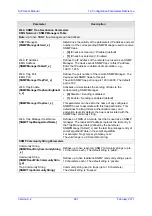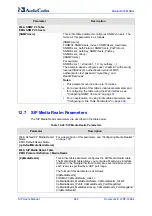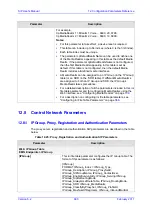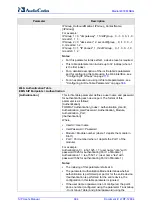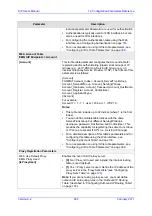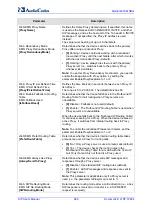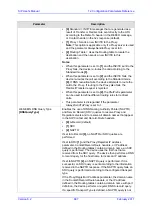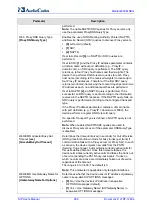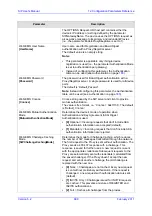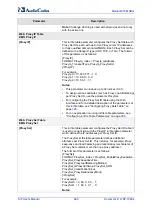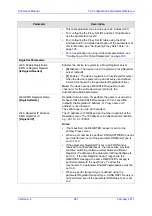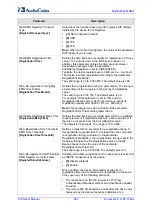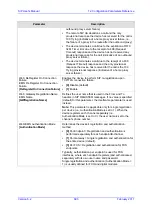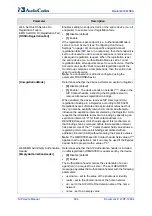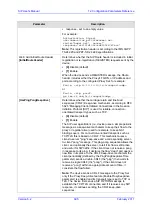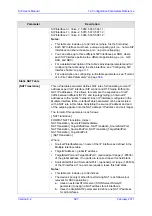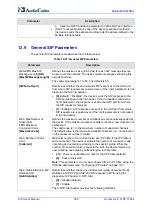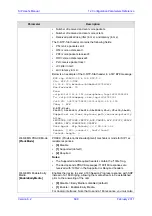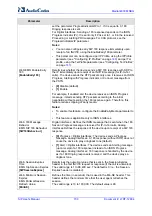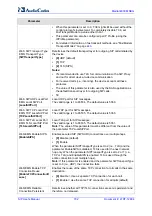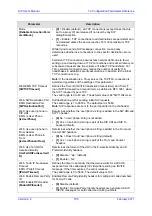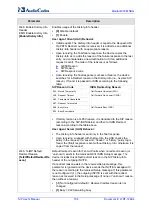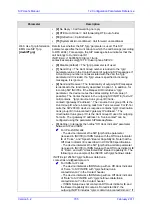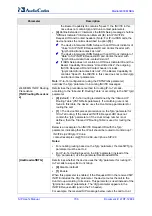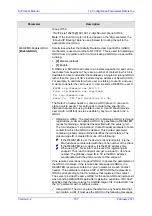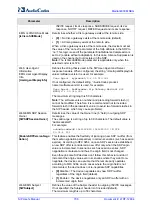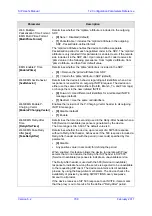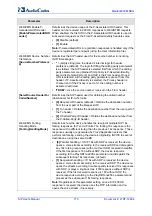
Version 6.2
695
February 2011
SIP User's Manual
12. Configuration Parameters Reference
Parameter
Description
response - set to an empty value
For example:
Authorization: Digest
[email protected],
realm=”home1.net”, nonce=””,
response=”e56131d19580cd833064787ecc”
Note:
This registration header is according to the IMS 3GPP
TS24.229 and PKT-SP-24.220 specifications.
Web: Add initial Route Header
[InitialRouteHeader]
Determines whether the SIP Route header is included in initial
registration or re-registration (REGISTER) requests sent by the
device.
[0]
Disable (default)
[1]
Enable
When the device sends a REGISTER message, the Route
header includes either the Proxy's FQDN, or IP address and
port according to the configured Proxy Set, for example:
Route: <sip:10.10.10.10;lr;transport=udp>
or
Route: <sip: pcscf-
gm.ims.rr.com;lr;transport=udp>
[UsePingPongKeepAlive]
Determines whether the carriage-return and line-feed
sequences (CRLF) Keep-Alive mechanism, according to RFC
5626 “Managing Client-Initiated Connections in the Session
Initiation Protocol (SIP)” is used for reliable, connection-
orientated transport types such as TCP.
[0]
Disable (default)
[1]
Enable
The SIP user agent/client (i.e., device) uses a simple periodic
message as a keep-alive mechanism to keep their flow to the
proxy or registrar alive (used for example, to keep NAT
bindings open). For connection-oriented transports such as
TCP/TLS this is based on CRLF. This mechanism uses a
client-to-server "ping" keep-alive and a corresponding server-
to-client "pong" message. This ping-pong sequence allows the
client, and optionally the server, to tell if its flow is still active
and useful for SIP traffic. If the client does not receive a pong
in response to its ping, it declares the flow “dead” and opens a
new flow in its place. In the CRLF Keep-Alive mechanism the
client periodically (defined by the PingPongKeepAliveTime
parameter) sends a double-CRLF (the "ping") then waits to
receive a single CRLF (the "pong"). If the client does not
receive a "pong" within an appropriate amount of time, it
considers the flow failed.
Note:
The device sends a CRLF message to the Proxy Set
only if the Proxy Keep-Alive feature (EnableProxyKeepAlive
parameter) is enabled and its transport type is set to TCP or
TLS. The device first sends a SIP OPTION message to
establish the TCP/TLS connection and if it receives any SIP
response, it continues sending the CRLF keep-alive
sequences.
Summary of Contents for Mediant 800 MSBG
Page 2: ......
Page 366: ...SIP User s Manual 366 Document LTRT 12804 Mediant 800 MSBG Reader s Notes ...
Page 372: ...SIP User s Manual 372 Document LTRT 12804 Mediant 800 MSBG Reader s Notes ...
Page 390: ...SIP User s Manual 390 Document LTRT 12804 Mediant 800 MSBG Reader s Notes ...
Page 404: ...SIP User s Manual 404 Document LTRT 12804 Mediant 800 MSBG Reader s Notes ...
Page 616: ...SIP User s Manual 616 Document LTRT 12804 Mediant 800 MSBG Reader s Notes ...
Page 636: ...SIP User s Manual 636 Document LTRT 12804 Mediant 800 MSBG Reader s Notes ...
Page 652: ...SIP User s Manual 652 Document LTRT 12804 Mediant 800 MSBG Reader s Notes ...
Page 886: ...SIP User s Manual 886 Document LTRT 12804 Mediant 800 MSBG Reader s Notes ...

